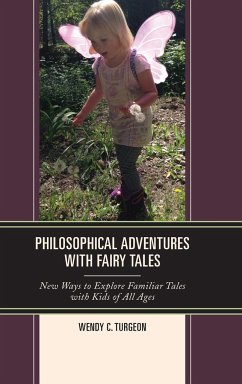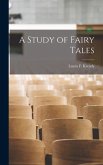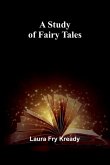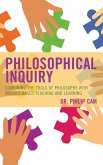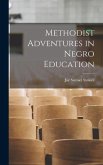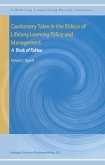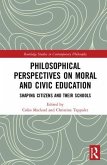Wendy C. Turgeon
Philosophical Adventures with Fairy Tales
New Ways to Explore Familiar Tales with Kids of All Ages
Wendy C. Turgeon
Philosophical Adventures with Fairy Tales
New Ways to Explore Familiar Tales with Kids of All Ages
- Gebundenes Buch
- Merkliste
- Auf die Merkliste
- Bewerten Bewerten
- Teilen
- Produkt teilen
- Produkterinnerung
- Produkterinnerung
The scope of the book is to offer guidelines to doing philosophy with children and young people using some familiar fairy tales.
Andere Kunden interessierten sich auch für
![A Study of Fairy Tales A Study of Fairy Tales]() Laura F KreadyA Study of Fairy Tales35,99 €
Laura F KreadyA Study of Fairy Tales35,99 €![A Study of Fairy Tales A Study of Fairy Tales]() Laura Fry KreadyA Study of Fairy Tales17,99 €
Laura Fry KreadyA Study of Fairy Tales17,99 €![Philosophical Inquiry Philosophical Inquiry]() Philip CamPhilosophical Inquiry77,99 €
Philip CamPhilosophical Inquiry77,99 €![Methodist Adventures in Negro Education Methodist Adventures in Negro Education]() Jay Samuel StowellMethodist Adventures in Negro Education32,99 €
Jay Samuel StowellMethodist Adventures in Negro Education32,99 €![Cautionary Tales in the Ethics of Lifelong Learning Policy and Management Cautionary Tales in the Ethics of Lifelong Learning Policy and Management]() Richard G. BagnallCautionary Tales in the Ethics of Lifelong Learning Policy and Management108,99 €
Richard G. BagnallCautionary Tales in the Ethics of Lifelong Learning Policy and Management108,99 €![Philosophical Perspectives on Moral and Civic Education Philosophical Perspectives on Moral and Civic Education]() Philosophical Perspectives on Moral and Civic Education180,99 €
Philosophical Perspectives on Moral and Civic Education180,99 €![The Adventures of Oliver Twist / by Charles Dickens; Edited With Introduction and Notes by Frank W. Pine The Adventures of Oliver Twist / by Charles Dickens; Edited With Introduction and Notes by Frank W. Pine]() Charles DickensThe Adventures of Oliver Twist / by Charles Dickens; Edited With Introduction and Notes by Frank W. Pine40,99 €
Charles DickensThe Adventures of Oliver Twist / by Charles Dickens; Edited With Introduction and Notes by Frank W. Pine40,99 €-
-
-
The scope of the book is to offer guidelines to doing philosophy with children and young people using some familiar fairy tales.
Produktdetails
- Produktdetails
- Verlag: Rowman & Littlefield Publishers
- Seitenzahl: 184
- Erscheinungstermin: 8. April 2020
- Englisch
- Abmessung: 235mm x 157mm x 15mm
- Gewicht: 426g
- ISBN-13: 9781475853223
- ISBN-10: 147585322X
- Artikelnr.: 58411530
- Herstellerkennzeichnung
- Libri GmbH
- Europaallee 1
- 36244 Bad Hersfeld
- gpsr@libri.de
- Verlag: Rowman & Littlefield Publishers
- Seitenzahl: 184
- Erscheinungstermin: 8. April 2020
- Englisch
- Abmessung: 235mm x 157mm x 15mm
- Gewicht: 426g
- ISBN-13: 9781475853223
- ISBN-10: 147585322X
- Artikelnr.: 58411530
- Herstellerkennzeichnung
- Libri GmbH
- Europaallee 1
- 36244 Bad Hersfeld
- gpsr@libri.de
Wendy C. Turgeon teaches philosophy to undergraduates at St. Joseph's College-New York and for years taught a course at Stony Brook University to graduate students in philosophy with children. She has published in the field of philosophy for/with children and presented at conferences for many years. Her other areas of interest are aesthetics, environmental ethics, and medieval philosophy.
Part I: Doing philosophy with children and young people
Chapter 1: Brief overview of the book with guidelines on how to use it
depending upon the audience (parents, teachers, philosophy club moderators,
interested readers)
Chapter 2: Introduction to philosophical inquiry with children and young
people (and adults)
Value of questions and the criteria for good thinking
Having a philosophical dialogue: guidelines for the family, for the
classroom, for the philosophy club
Chapter 3: Why Fairy Tales for philosophy?
Benefits of "doing philosophy" and problematizing fairy tales, including a
short guiding review of current literature on this topic
Part II: Fairy Tales and Philosophy
Chapter 4: Introductory Chapter: where to find fairy tales
Some Notes on the Sources [If you want this separate from the intro
chapter]
Chapter 5: The Frog King or Iron Heinrich
Chapter 6: Rapunzel
Chapter 7: Fitcher's Bird
Chapter 8: Little Red Riding Hood
Chapter 9: The White Snake
Chapter 10: The Little Mermaid
Chapter 11: The Seven Ravens
Chapter 12: Cinderella
Chapter 13: Beauty and the Beast
Chapter 14: Hansel and Gretel
Chapter 15: Snow White
Chapter 16; Puss 'n Boots
Chapter 17: The Three Bears
Appendix A: Sources for more information about philosophy and children
Appendix B: Contemporary Reimagining of Classic Fairy Tales
Appendix C: List of the themes in the Fairy Tales chapters
About the Author
Chapter 1: Brief overview of the book with guidelines on how to use it
depending upon the audience (parents, teachers, philosophy club moderators,
interested readers)
Chapter 2: Introduction to philosophical inquiry with children and young
people (and adults)
Value of questions and the criteria for good thinking
Having a philosophical dialogue: guidelines for the family, for the
classroom, for the philosophy club
Chapter 3: Why Fairy Tales for philosophy?
Benefits of "doing philosophy" and problematizing fairy tales, including a
short guiding review of current literature on this topic
Part II: Fairy Tales and Philosophy
Chapter 4: Introductory Chapter: where to find fairy tales
Some Notes on the Sources [If you want this separate from the intro
chapter]
Chapter 5: The Frog King or Iron Heinrich
Chapter 6: Rapunzel
Chapter 7: Fitcher's Bird
Chapter 8: Little Red Riding Hood
Chapter 9: The White Snake
Chapter 10: The Little Mermaid
Chapter 11: The Seven Ravens
Chapter 12: Cinderella
Chapter 13: Beauty and the Beast
Chapter 14: Hansel and Gretel
Chapter 15: Snow White
Chapter 16; Puss 'n Boots
Chapter 17: The Three Bears
Appendix A: Sources for more information about philosophy and children
Appendix B: Contemporary Reimagining of Classic Fairy Tales
Appendix C: List of the themes in the Fairy Tales chapters
About the Author
Part I: Doing philosophy with children and young people
Chapter 1: Brief overview of the book with guidelines on how to use it
depending upon the audience (parents, teachers, philosophy club moderators,
interested readers)
Chapter 2: Introduction to philosophical inquiry with children and young
people (and adults)
Value of questions and the criteria for good thinking
Having a philosophical dialogue: guidelines for the family, for the
classroom, for the philosophy club
Chapter 3: Why Fairy Tales for philosophy?
Benefits of "doing philosophy" and problematizing fairy tales, including a
short guiding review of current literature on this topic
Part II: Fairy Tales and Philosophy
Chapter 4: Introductory Chapter: where to find fairy tales
Some Notes on the Sources [If you want this separate from the intro
chapter]
Chapter 5: The Frog King or Iron Heinrich
Chapter 6: Rapunzel
Chapter 7: Fitcher's Bird
Chapter 8: Little Red Riding Hood
Chapter 9: The White Snake
Chapter 10: The Little Mermaid
Chapter 11: The Seven Ravens
Chapter 12: Cinderella
Chapter 13: Beauty and the Beast
Chapter 14: Hansel and Gretel
Chapter 15: Snow White
Chapter 16; Puss 'n Boots
Chapter 17: The Three Bears
Appendix A: Sources for more information about philosophy and children
Appendix B: Contemporary Reimagining of Classic Fairy Tales
Appendix C: List of the themes in the Fairy Tales chapters
About the Author
Chapter 1: Brief overview of the book with guidelines on how to use it
depending upon the audience (parents, teachers, philosophy club moderators,
interested readers)
Chapter 2: Introduction to philosophical inquiry with children and young
people (and adults)
Value of questions and the criteria for good thinking
Having a philosophical dialogue: guidelines for the family, for the
classroom, for the philosophy club
Chapter 3: Why Fairy Tales for philosophy?
Benefits of "doing philosophy" and problematizing fairy tales, including a
short guiding review of current literature on this topic
Part II: Fairy Tales and Philosophy
Chapter 4: Introductory Chapter: where to find fairy tales
Some Notes on the Sources [If you want this separate from the intro
chapter]
Chapter 5: The Frog King or Iron Heinrich
Chapter 6: Rapunzel
Chapter 7: Fitcher's Bird
Chapter 8: Little Red Riding Hood
Chapter 9: The White Snake
Chapter 10: The Little Mermaid
Chapter 11: The Seven Ravens
Chapter 12: Cinderella
Chapter 13: Beauty and the Beast
Chapter 14: Hansel and Gretel
Chapter 15: Snow White
Chapter 16; Puss 'n Boots
Chapter 17: The Three Bears
Appendix A: Sources for more information about philosophy and children
Appendix B: Contemporary Reimagining of Classic Fairy Tales
Appendix C: List of the themes in the Fairy Tales chapters
About the Author

